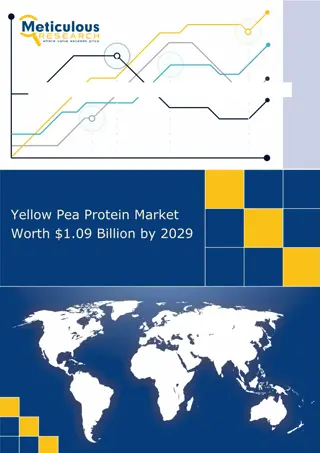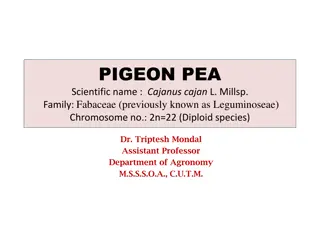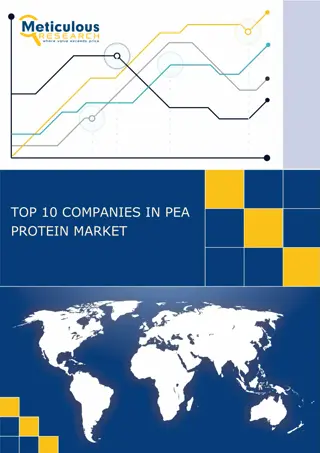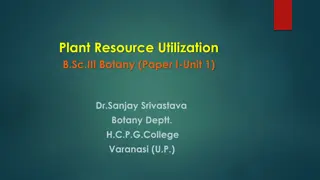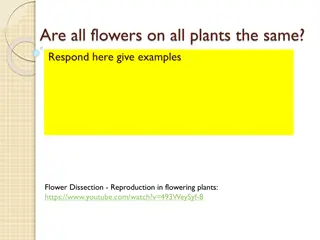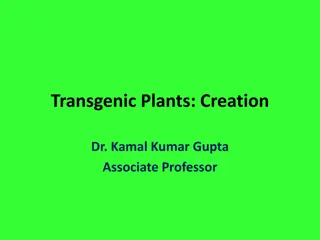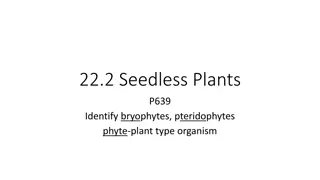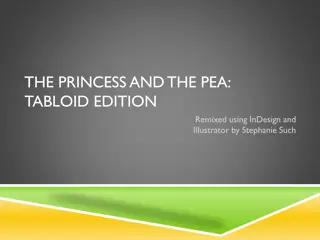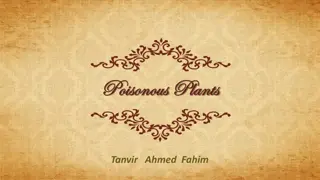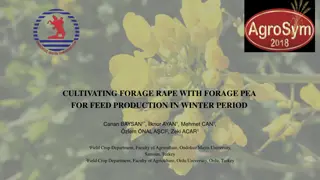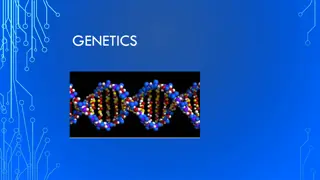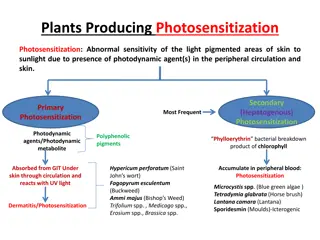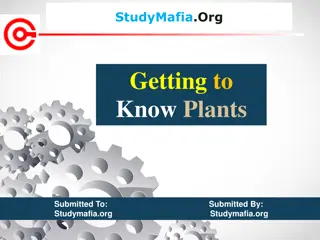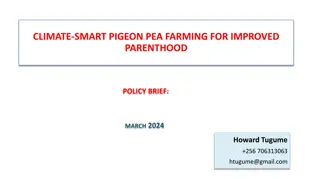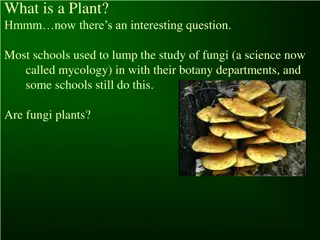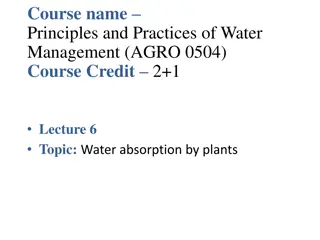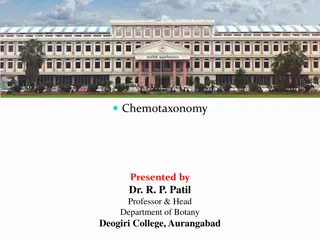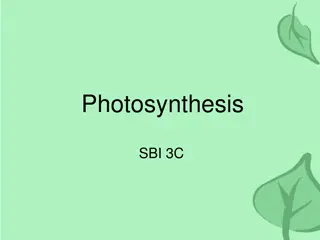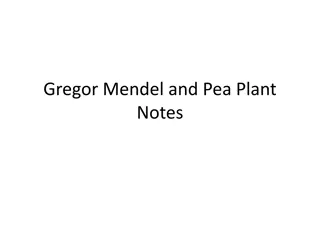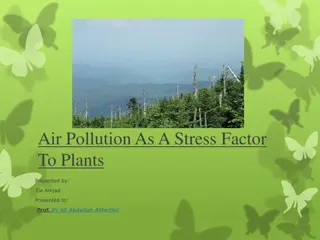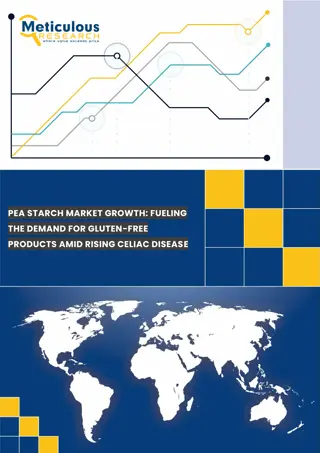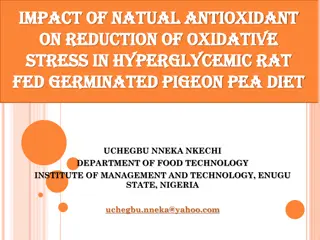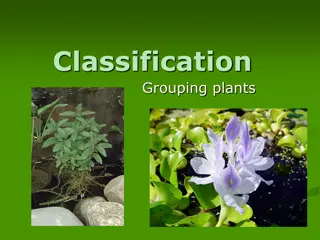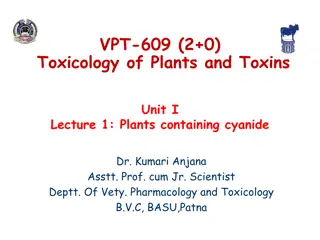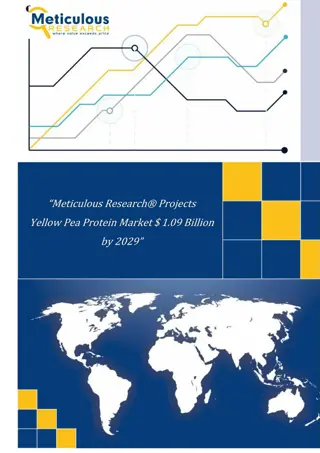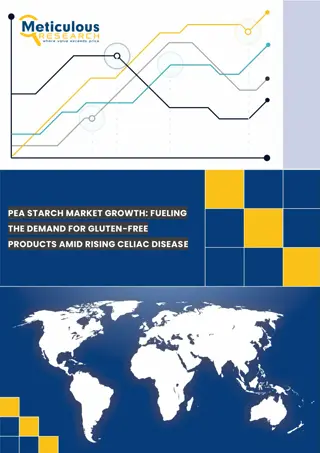Energy Production
Explore different aspects of energy production and efficiency in thermal power plants, water heaters, coal-fired electrical generation plants, and natural gas electrical generation plants. Learn about energy density, mass calculations, overall efficiencies, and specific energy requirements in these
7 views • 57 slides
Anticipated Growth: Yellow Pea Protein Market to Reach $1.09 Billion by 2029
According to this latest publication from Meticulous Research\u00ae, the yellow pea protein market is expected to reach $1.09 billion by 2029, at a CAGR of 15.8% from 2022 to 2029.\n
1 views • 4 slides
Pigeon Pea (Cajanus cajan L. Millsp) - Overview, Importance, and Uses
Pigeon pea, scientifically known as Cajanus cajan L. Millsp, is a significant kharif pulse in India. It is rich in protein, carbohydrates, fiber, and essential minerals. The plant provides nutritious grains, cattle feed, and fuel. Pigeon pea withstands soil moisture deficits, making it vital in dryl
0 views • 23 slides
PEA PROTEIN MARKET
The Pea Protein Market is projected to reach $1.14 billion by 2029, growing at a compound annual growth rate (CAGR) of 15.7% from 2022 to 2029. In terms of volume, the global pea protein market is expected to expand at a CAGR of 12.7% during the same period, reaching 4.68 million tons by 2029.
2 views • 4 slides
Production and Uses of Wheat, Rice, Legumes, and Sugarcane
Cereals like wheat and rice, along with legumes such as pigeon pea and gram, play vital roles in food production and consumption. Wheat, known for its versatility in various forms like flour, bread, and beer, is a significant crop globally. Rice, a staple in many parts of the world, requires process
0 views • 12 slides
Understanding Flower Variations in Plants
Explore the diverse world of flowers in plants through examples and explanations of their reproductive parts and processes. Discover how some plants have both male and female flowers, while others have separate sex flowers. Learn about perfect flowers, the female and male parts of a flower, and the
0 views • 12 slides
Understanding Thermal Power Plants: Overview and Operation
Thermal power plants play a crucial role in converting heat energy into electricity for various applications. This article covers the definition, layout, working principle, and components of thermal power plants, highlighting their advantages and top features. From converting heat into mechanical po
0 views • 20 slides
Understanding Transpiration and Gas Exchange in Plants
Transpiration is the evaporation of water from plants, mainly occurring through the leaves' stomata. Plants exchange gases like CO2 and O2 through various parts, without specialized organs. The process aids in photosynthesis, respiration, and cooling, demonstrating the importance of transpiration in
0 views • 22 slides
Understanding Transgenic Plants and Agrobacterium Tumefaciens in Plant Biotechnology
Creation of transgenic plants involves various methods such as microprojectile DNA-coating, electroporation, and Agrobacterium transformation. Agrobacterium tumefaciens, a soil bacterium, plays a crucial role in inducing crown gall disease in plants by transferring T-DNA from the Ti plasmid. The Ti
1 views • 27 slides
Understanding Seedless Plants: Bryophytes and Pteridophytes
Explore the world of seedless plants through bryophytes and pteridophytes. Learn about the characteristics of green algae, the life cycles of these plants, and how vascular tissue impacts their growth. Discover the limitations and importance of vascular tissue in plants, from the small yet significa
0 views • 8 slides
Remixed Tale: The Princess and the Pea Tabloid Edition
Delve into "The Princess and the Pea" reimagined in a tabloid edition, created using InDesign and Illustrator by Stephanie Such. Explore the story, design choices, modal communication methods, challenges faced, successes achieved, and reflections on what could have been done differently. With a focu
0 views • 10 slides
Pea Protein Market
According to a recent Meticulous Research\u00ae report, the global pea protein market is projected to grow at a CAGR of 15.7% from 2022 to 2029, reaching $1.14 billion by 2029, and expanding at a volume CAGR of 12.7% to 4.68 million tons. This growth
1 views • 4 slides
Understanding Poisonous Plants and Their Effects on Humans
Poisonous plants can have deleterious effects on individuals, leading to severe consequences and even death if not managed properly. These plants produce toxins that interfere with the body's essential functions, ultimately causing impairment and potential fatality. Recognizing the grades of poisoni
0 views • 11 slides
Understanding Food Sources: Plants and Animals Explained
Food is essential for nourishing our bodies, and it comes from either plants or animals. Plants provide fruits, vegetables, grains, and more, while animals offer products like meat, milk, and eggs. Different parts of plants, such as roots, stems, and leaves, are consumed as food. Animals have varied
0 views • 11 slides
Pea Starch
Explore $307.4 million Pea Starch |: Get exclusive insights on key trends, segments, geographical analysis, & competitive analysis!
1 views • 4 slides
Mineral Absorption in Plants: Mechanisms and Types
Plants absorb minerals from the soil as ions through the roots, with the process of mineral absorption being distinct from water absorption. Mineral absorption in plants can occur through passive or active methods, each involving different mechanisms and energy requirements. Passive absorption is a
0 views • 14 slides
Cultivating Forage Rape with Forage Pea for Winter Feed Production
Cultivating forage rape alongside forage pea provides a practical solution for feed production during the winter period. Forage rape, traditionally an oil crop, is now being utilized as fresh herbage, hay, or silage for ruminants. By mixing forage rape with forage pea, the detrimental effects of ant
0 views • 19 slides
Asexual Reproduction in Plants: Methods and Examples
Asexual reproduction in plants, also known as vegetative propagation, involves various methods such as tubers, bulbs, and runners. It allows plants to reproduce without the involvement of sex cells and fertilization, resulting in genetically identical offspring. Artificial propagation techniques lik
0 views • 11 slides
Exploring the Legacy of Gregor Mendel: Pioneer of Genetics
Gregor Mendel, a father monk in the 1800s, conducted groundbreaking research on how traits are inherited through plants, laying the foundation for modern genetics. Despite initial lack of recognition, his work on pea plants led to the discovery of genetic factors and the understanding of hereditary
0 views • 43 slides
Understanding Photosensitization in Plants: Causes and Toxicity
Photosensitization in plants can lead to abnormal skin sensitivity to sunlight, caused by the presence of photodynamic agents in the skin and peripheral circulation. Primary and secondary photosensitization are common, with various plants and toxins contributing to liver damage and biliary occlusion
0 views • 12 slides
Exploring the World of Plants: An Overview
Plants play a vital role in sustaining life on Earth by producing food and oxygen. This comprehensive guide delves into the diverse types of plants, such as herbs, shrubs, trees, creepers, and climbers. It also discusses the essential components of plants, like leaves, transpiration, and photosynthe
0 views • 20 slides
Enhancing Parenthood through Climate-Smart Pigeon Pea Farming
Pigeon peas play a vital role in climate-smart agriculture, impacting farmers' roles as parents in ways not previously studied. Research objectives included validating parenthood among pigeon pea farmers and analyzing factors influencing parenthood. Key findings highlighted gender differences in inc
0 views • 8 slides
A Closer Look at Plants and Their Importance in Our Ecosystem
Plants play a vital role in our ecosystem, not only through photosynthesis but also in regulating atmospheric gases like oxygen and carbon dioxide. Understanding the definition of plants, from green algae to flowering plants, is essential. By studying plants, we uncover their critical contribution t
0 views • 12 slides
Understanding Plant Classification and Characteristics
Discover the classification of plants based on their structures and characteristics, including vascular vs. nonvascular plants, seed plants vs. seedless plants, and the definitions of angiosperms, gymnosperms, dicots, and monocots. Learn about the history of plant classification and how plants are g
0 views • 27 slides
Water Absorption by Plants: Mechanisms and Adaptation Strategies
Understanding water absorption by plants is crucial for effective water management in agriculture. Plants absorb water through active and passive methods, driven by osmotic and non-osmotic processes. Root hairs play a significant role in facilitating water uptake, with mechanisms such as osmotic act
0 views • 26 slides
Beware of Pests and Diseases on Plants - Protect Your Home Garden
Pests and diseases can easily hide on plants, seeds, fruits, vegetables, and flowers, posing a threat to your home garden. Bringing infected plants home can lead to widespread infestations and damage. It's crucial to be vigilant and avoid importing potentially contaminated greenery. Stay informed, i
0 views • 4 slides
Understanding Chemotaxonomy: Classification of Plants Based on Chemical Constituents
Chemotaxonomy, presented by Dr. R. P. Patil, explores the scientific investigation of the chemical characters in plants for taxonomy and phylogeny studies. It involves classifying plants based on their chemical constituents and molecular characteristics. Principles, methods, and importance of chemot
0 views • 24 slides
Understanding Photosynthesis: The Process of Energy Conversion in Plants
Photosynthesis is a vital process where plants, algae, and cyanobacteria convert light energy from the sun into chemical energy in the form of glucose. This energy conversion involves the absorption of light by chlorophyll molecules in chloroplasts, leading to the generation of ATP and the formation
0 views • 12 slides
The Legacy of Gregor Mendel: Father of Genetics and Pea Plant Experiments
Gregor Mendel, a monk from the 1800s, conducted groundbreaking experiments with pea plants to study inheritance patterns. By meticulously observing traits like seed color and pod shape, Mendel discovered the principles of heredity and laid the foundation for modern genetics. His work on dominant and
0 views • 33 slides
Diversity of Plants in Rivers and Streams
In rivers and streams, a variety of plants play essential roles by providing shelter, food, and oxygen to animals. From white poplar to water lilies, different plants thrive along riverbanks and in water bodies, contributing to the ecosystem's health and balance. Aquatic plants like water lettuce an
0 views • 6 slides
Pea Starch
Explore $307.4 million Pea Starch Get exclusive insights on key trends, segments, geographical analysis, & competitive analysis!
1 views • 4 slides
Gregor Mendel and His Work with Pea Plants
Gregor Mendel, an Austrian monk born in 1822, is known as the father of genetics for his groundbreaking work with pea plants. By carefully examining traits such as stem height, flower color, and seed shape, Mendel discovered the principles of dominant and recessive alleles. His experiments with pea
0 views • 14 slides
Understanding Air Pollution Stress on Plants
The impact of air pollution on plants is a significant concern, affecting their physiology and overall health. Various air pollutants, such as sulfur dioxide, ozone, and nitrogen compounds, have been identified as phytotoxic agents, leading to severe or subtle effects on plant life. Detecting the ef
0 views • 21 slides
Pea Starch
Explore $307.4 million Pea Starch Get exclusive insights on key trends, segments, geographical analysis, & competitive analysis!
1 views • 4 slides
Impact of Natural Antioxidant on Reducing Oxidative Stress in Hyperglycemic Rats Fed Germinated Pigeon Pea Diet
Diabetes, a metabolic disorder characterized by hyperglycemia, affects millions worldwide. Oxidative stress plays a key role in its pathogenesis, leading to decreased antioxidant capacity. This study explores the potential of natural antioxidants from germinated pigeon pea to reduce oxidative stress
0 views • 19 slides
Plant Classification and Reproduction Overview
Plants are categorized into four groups: Mosses, Ferns, Conifers, and Flowering Plants. Mosses reproduce by spores and lack roots or xylem vessels. Ferns reproduce via spores, while conifers reproduce with seeds found in cones and have needle-shaped leaves. Flowering plants reproduce using seeds fou
0 views • 8 slides
Understanding Cyanogenic Plants and Cyanide Poisoning in Animals
This lecture introduces the toxicology of plants containing cyanide, focusing on factors affecting cyanide poisoning, cyanogenic plants, mechanisms of toxicosis, clinical signs, post-mortem lesions, diagnosis, treatment, and prevention. It discusses species variations in susceptibility, plant growth
0 views • 22 slides
The Future of Nutrition: Insights into the Yellow Pea Protein Market (2022-2029)
Meticulous Research\u00ae projects the yellow pea protein market will reach $1.09 billion by 2029, growing at 15.8% CAGR. Key drivers include plant-based nutrition demand and health trends. North America leads the market, while Asia-Pacific is expect
0 views • 7 slides
Gregor Mendel: The Father of Genetics and His Pea Plant Experiments
Gregor Mendel, an Austrian botanist monk, laid the foundation for the study of heredity with his groundbreaking work on pea plants in the mid-1800s. By observing traits across generations, Mendel formulated the basic laws of genetics, demonstrating how traits are inherited. His experiments with pure
0 views • 18 slides
Pea Starch
Explore $307.4 million Pea Starchet exclusive insights on key trends, segments, geographical analysis, & competitive analysis!
1 views • 4 slides

